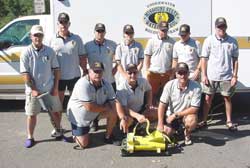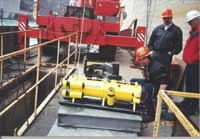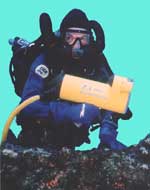
Underwater camera systems are letting us study and explore the two-thirds of our planet that is covered by water as we never have before. A company in Massachusetts, JW Fishers Mfg., has been designing and building specialized underwater video systems for almost two decades. These high tech cameras transmit live video from the ocean bottom through an umbilical cable to the surface allowing real time viewing of the undersea world. Fishers cameras are in use by scientists, universities, law enforcement agencies, dive rescue groups, commercial diving companies, and shipwreck explorers around the world. Here are some examples of how underwater cameras are helping these diverse groups.
Cameras that can see underwater are allowing scientists to study the marine environment to an extent that was not previously possible. When the National Institute of Oceanography in India wanted to study benthic habitats in their coastal waters, they realized a camera system with some mobility would be needed. After researching the various types of remote operated vehicles or “ROVs”, it was decided that Fishers SeaOtter would best meet their requirements. This high tech, motorized underwater camera has the ability to “swim” along the ocean bottom allowing the institute’s scientists to closely observe the plant and animal life there. A marine biologist in Chile, Dr. Carlos Guerra Correa, and his aquaculture engineer wife Alexandra, are using their SeaOtter to conduct environmental studies in rivers and bays. “One of the primary applications of the ROV is to monitor benthic communities near industrial discharges of warm water. It is much easier to assess the environmental impact when you can see the marine animals and the condition of their habitat, rather than just relying on water quality samples.” says Dr. Correa.
Researchers of commercial fisheries also depend on underwater camera systems to help them gather critical data. When a group of marine biologists in Fairbanks wanted study bottom fishing in the Gulf of Alaska, it found the right equipment for the job in Fishers TOV-1 towed video system. This underwater camera uses the propulsion of the boat to pull it through the water. The towed camera was deployed beside trawl nets set up in various configurations to see which most effectively captured fish. They were surprised by how much information the underwater “eyeball” provided them on the performance of each net. And in the Middle East, scientists at Bahrain’s Center for Studies and Research are using the TOV-1 “to perform sea bottom surveys and to monitor the performance of BRDs (By-catch Reduction Devices)”, says Dr. Ebrahim Abdulqader. “The camera allows us to actually see which BRDs work most effectively in releasing the species we want to preserve.” Another commercial fishery where underwater cameras are becoming an essential piece of equipment is the harvesting of black coral. This precious gem of the underwater world often grows at depths in excess of 100 feet. Robin Lee a coral diver in Hawaii says, “We regularly dive to depths of 150 to 250 feet. If we go down and there’s nothing there, we’re done for the day, there’s no second dive at those depths. Using our TOV-1 we can locate the coral trees before going down. The camera ensures that each dive we make is a productive one, but we don’t just go down and clear cut an area, we selectively harvest it. Here in the islands black coral is managed as a sustainable resource.”
Government agencies are also finding the underwater camera to be an important tool in their work. When the Ohio Department of Natural Resources needed to study large tracts of underwater geology, it found the towed video to be the perfect solution. “The towed video allows us to examine miles of the Ohio River bottom without having the limitations of scuba diving”, proclaimed the department’s Dale Lieventhal. The US Dept of the Interior’s Geological Survey Division confirms Dale’s findings. In a report titled “Use of Remote-Sensing Techniques to Survey the Physical Habitat of Large Rivers”, they called the TOV-1 an effective tool for survey work. The report goes on to say, “These systems (remote underwater cameras) are compact and portable, and can be easily used to describe the physical environment, to provide ground truth information for side scan sonar surveys, and make micro habitat observations for species of interest.”
Serious scientific work isn’t the only thing underwater cameras a used for. State agencies responsible for control and inspection of reservoirs and water supply lines, like the New York Department of Environmental Protection and the City of San Diego Water Operations & Support Group, are also utilizing underwater cameras. In New York, a Fisher ROV was deployed into an 800 foot deep, water filled shaft to locate and inspect a leaky valve in one of the main lines supplying water to NY city. Previously, this type of operation would have required draining the shaft to locate the problem or calling in a commercial diving company to do a saturation dive. Both are time consuming and expensive processes. Deploying an ROV allowed the inspection to be performed quickly and inexpensively.
Another responsibility charged to state agencies is the preservation of submerged natural resources and historic sites. Underwater camera systems play an important role in performing this work. In South Carolina, the Department of Natural Resources is using one of Fishers ROVs to inspect reef structures and to videotape underwater archeological sites. The camera allows regular monitoring of these resources without the need to deploy divers. This is especially important with deep water sites, like the civil war iron clad Monitor at a depth of over 200 feet. The condition of the wreck can be regularly monitored without having divers do a risky decompression dive. The Darling Marine Center at the University of Maine is using their Fisher drop camera for an archeological project. They are videotaping the wreckage of the infamous Penobscot Expedition of 1779, long considered the worst naval defeats in US history prior to Pearl Harbor. The camera allows the archeologists to construct a video map of the site before beginning excavation.
Underwater cameras are also used extensively by power companies to perform inspections of dams and other underwater structures. Ontario Power in Toronto needed a way to inspect the tailrace, concrete piers, head-works, sluiceway aprons and draft tubes at several of their plants. Conditions were too dangerous to deploy divers so they chose Fishers SeaLion ROV for the job. The maneuverability of the ROV allowed it to easily reach various parts of the dam structure even in the high current environment. The SeaLion is also being used by the Army Corps of Engineers for dam inspection projects at the Ice Harbor Dam in Pasco, Washington and Youghiogheny Dam, in Confluence, Pennsylvania.
Commercial divers and marine services companies depend on underwater camera systems to assist in their operations too. Employing cameras allows them to reduce the amount of time divers have to spend in the water and completely eliminate the need to dive on some projects. Luigi Carrassi owner of the marine services company Dicol in Venezuela says, “Using underwater cameras allows us to inspect sites before putting divers down. That way we know we’re on target and have what we’re looking for before the divers are sent in. This saves time and money.” When engineers at the New York Canal System had a problem opening one of the gates in a lock, they called Joe Plano of the Aquatic Center in Rochester with his SeaOtter. The ROV descended to the bottom of the lock and through a tunnel to find the stuck gate, all in near zero visibility. The camera was able to videotape the gate’s locking mechanism allowing officials to come up with a solution to the problem, all without having to put a diver into a potentially dangerous environment. And in Sri Lanka, marine service provider Colombo Engineering, used one of Fishers diver-held camera systems to videotape a problem with a propeller on a sea-going freighter. It was discovered thatone of the four propeller blades had been sheared off causing an extremely bad vibration in the vessel’s drive system. A marine architect was able to view a videotape of the damaged prop and come up with a temporary solution, which was to cut off the blade opposite of the broken blade. This allowed the ship to continue on to its destination without having to be dry-docked, a very expensive and time-consuming procedure.
Another group making extensive use of underwater cameras are law enforcement agencies and dive rescue groups. These dive teams are using Fishers video systems to help them locate drowning victims and to search for importance evidence, such as a weapon that was disposed of in a waterway. Groups like the Baxter County Sheriffs Department in Arkansas and the Missouri State Water Patrol regularly use their towed video systems to conduct searches in cold, dark lakes thus reducing the risk to their public safety divers. When a waterfront nightclub collapsed into the Delaware River, casting dozens of patrons into the chilly waters and killing three, the Philadelphia Marine Police were quickly called in. Using their Fisher underwater camera they were able to assess the treacherous underwater scene before deploying divers to search for the victims.
Underwater cameras are also being used to educate and entertain the general public. They can help those of us who have a less knowledge about the ocean and it’s creatures, develop a better understanding. When a charter boat captain in Maine was looking for a way to increase his share of summer tourist traffic, he found the answer by putting a SeaOtter on board. Guests on the boat not only have the opportunity to view the scenic New England seashore, but are also treated to a show of the marine life that inhabits local bays and inlets. Visitors have a chance to see fish, lobsters, crabs, octopus, starfish, seals, seahorses, and a variety of other underwater creatures - all in their native habitat. “It’s wonderful learning experience, and folks are thoroughly entertained by it”, says Capt. Michael Day. A cruise line operator found this to be true too. American Canadian Cruises, known as the “small ship” cruise line wanted to give their customers another reason to travel with them so the owners installed Fishers dropped video systems on board. When the ship reaches its various ports-of-call the camera is lowered over the side and guests can view all types of exotic marine life on wide screens TVs set up the vessel’s lounge, without ever putting a toe in the water.
Probably the most exciting use of underwater cameras is in finding shipwrecks and assisting in the search for the treasures on board. Everyone that saw the movie “Titanic” witnessed the impressive capabilities of an ROV. The remote operated vehicle let us view the wreckage of the huge ocean liner as it sat eerily motionless on the ocean floor at over 12,000 feet deep. Even more amazing to see was the interior of the ship as the ROV “swam” down the grand staircase and into the main ballroom. A number of ROVs have also been equipped with special metal detectors which allow them to swim over a wreck site and locate treasure that has long been consumed by the ocean’s sediment. On the wreck of the Republic, an 1800s paddlewheeler and one of the richest shipwrecks ever discovered, an ROV equipped with a Fishers metal detector was able to locate hundreds of gold coins lying just under the muddy bottom. As the $20 gold pieces were brought to the surface and loaded onto the support vessel they saw the light of day for the first time since the Civil War.
These are only a few of the thousands of uses of underwater cameras systems in our world today. They are helping us gain a better understanding of our oceans and the creatures that live there, and are making life easier and safer for those that have to work there.


